Getting Into Bicycle Racing: Competing
Bicycle racing seems simple to outsiders because it appears that the strongest rider wins. But, it's actually like chess on wheels, where wins come as often from brains as from brawn. This is what makes it such a challenging sport and such a rewarding one when you finally break through and start placing and winning.
To help speed your learning curve, we've put together this article. Keep in mind that you'll improve fastest if you stay positive. Focus on having a good time. Don't put too much pressure on yourself. And, instead of worrying about mistakes, learn from them. Good luck!
Warming Up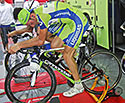 Even the pros get butterflies in their stomachs before races. A proper warm-up will help ease anxiety and it's crucial to get your body ready to race.
Even the pros get butterflies in their stomachs before races. A proper warm-up will help ease anxiety and it's crucial to get your body ready to race.
Your goal is to hurt your legs a little, break a sweat and raise your heart rate so you're breathing hard. To do this, spin easily for 15 minutes, gradually increasing your pace. Then do 3, 3-minute race-pace efforts with 3 minutes of recovery between. Once you're warm, pedal easily to the start.
Note that a trick to ease pre-race anxiety is warming up away from the other racers and the starting area. Find a quiet, peaceful spot to settle your nerves. And, keep in mind that you can do this same warm-up on a trainer right next to your vehicle, if you bring one to races. On the trainer, just listen to music to eliminate any distractions and get focused.
Bonus Tip: Don't worry if your legs feel dead or tired while warming up. That's common. And the feeling will go away in the race. Plus, it's better that your legs feel bad during the warm-up than the first time someone attacks.
The Start
The most common racing mistake is riding too hard too early in a race. So, remember that starts are always difficult. Start aggressively and expect to suffer a bit (this is why the warm-up is so important). But, try to start at a pace that's manageable for your legs and lungs, and don't go overly hard. Usually, even races that start super fast will soon settle into a good rhythm you'll find manageable.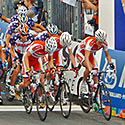 In a road race, it's imperative that you stay with the pack. In amateur races, especially criteriums, the first third of the race is often very difficult. Everyone is fresh so everyone wants to go fast. Weather this storm and wait until your competitors show signs of fatigue before you make any moves. Remember that when you're suffering, so are most of the other racers. Be strong and don't give up.
In a road race, it's imperative that you stay with the pack. In amateur races, especially criteriums, the first third of the race is often very difficult. Everyone is fresh so everyone wants to go fast. Weather this storm and wait until your competitors show signs of fatigue before you make any moves. Remember that when you're suffering, so are most of the other racers. Be strong and don't give up.
Racing off road you'll probably have chances to pass people. But ride steady and within your limits. Going super hard to get ahead of a few more people will often cost you later in the race. Save your energy for later when it matters the most.
Bonus Tip: To get a good start you need to be able to get into your clipless pedals quickly. To perfect this technique, practice getting into them (where it's safe), until you can do it quickly and smoothly every time without looking.
Basic Tactics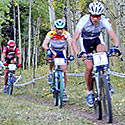 A great way to learn good pace is to find riders early in the race that are about your level, and stick with them. If they disappear up the trail or road, find a different group to stick with. Sit in at the back and enjoy the ride. You're sheltered from the wind back there so you can rest and recover.
A great way to learn good pace is to find riders early in the race that are about your level, and stick with them. If they disappear up the trail or road, find a different group to stick with. Sit in at the back and enjoy the ride. You're sheltered from the wind back there so you can rest and recover.
When you feel good enough, or if the bunch slows, you may want to pick it up and attempt to catch some people ahead. Just remember that it's always best to tuck in behind someone when possible, because you expend up to 30-percent less energy than you would riding alone.
Ride smart climbing and descending, too. If you climb too hard, you'll blow up and lose lots of time. And, speeding downhill when you're tired is dangerous. Don't risk it.
Bonus Tip: Here too, practice makes perfect. And a great place to practice riding with others and maintaining the pace is on group training rides. These aren't races but the group riding is very similar and helpful.
Nutrition
You can only store about 90 minutes worth of glycogen, which is what gives you energy, so in races longer than that you must eat to keep going strong. Carry bottles on your bike (or wear a hydration pack), and consume at least 20 ounces of water or sports drink over the course of every 45 minutes.
Drinks with complex and simple carbohydrates keep energy levels elevated and prevent cramping. Try different brands during training (rather than on race day) to determine which ones you like best and which won’t upset your stomach. During warmer races, you'll probably want a slightly higher percentage of water to 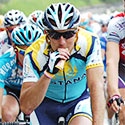 sports drink to prevent a sticky-sweet overload.
sports drink to prevent a sticky-sweet overload.
For food, energy gels and chews are great for short, intense races like criteriums, short mountain-bike races and cyclocross races, where you don't want to remove your hands from the bars for very long. Gels are the consistency of cake frosting so they go down fast and taste yummy. Eat one about every 30 minutes.
Road races and endurance mountain races are more difficult to eat for. If your race is under 3.5 hours, you'll probably get by with a combination of gels, sports drinks and energy bars. Remember that energy bars are harder to chew and swallow than gels, so you'll want to eat them during a lull in the action.
You'll also want to drink plenty of water to ensure proper digestion. Typically long, easy climbs and valleys where the pace is moderate are good places to eat. But, keep an eye on your competitors as they may attack while you try to refuel; a frowned-on yet common tactic.
In races over 3.5 hours you'll probably want to eat more "real" food. Popular foods include bananas, fig bars, cashews, pastries, peanut-butter-and-jelly sandwiches, or whip up your own gourmet rice cakes. These calorie-rich goodies are tasty, which ensures you'll eat when your stomach says no but your legs are begging for fuel. Another great way to get calories is to bring a bottle with a high-calorie drink mix that provides large quantities of carbohydrates, protein and, in some cases, nutritional fats.
Bonus Tip: Start drinking and eating within the first 30 minutes to train your body to metabolize the calories as you race. Then sip and nibble every 15 minutes. If you wait until you're hungry or thirsty, it's usually too late to absorb the fuel and you’ll begin to weaken and slow. You don't want that.
Sportsmanship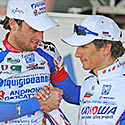 Competition brings out the best in athletes. Unfortunately, it can also bring out the worst. If someone cuts you off or causes you to nearly crash, try not to overreact. Why waste valuable energy arguing? Just shake it off and let your riding do your talking.
Competition brings out the best in athletes. Unfortunately, it can also bring out the worst. If someone cuts you off or causes you to nearly crash, try not to overreact. Why waste valuable energy arguing? Just shake it off and let your riding do your talking.
Likewise, if a mechanical breakdown knocks you out of the race, don’t lose it and hurl your bike against the closest object. Remember that you're doing this for fun and recreation! Take some deep breaths and accept your bad luck.
If you take stuff like this in stride and show your good sportsmanship, people remember how well you were riding. And if you curse, complain and make excuses, people remember that, too. How would you like to be remembered?
Bonus Tip: Experienced racers are usually quiet, confident competitors. Their calmness is a result of realizing that the person who wastes the least energy during the race has the best shot at winning.
Recovery
After you cross the finish line, don't spend too much time standing around. To speed recovery, pedal around the race area for about 20 minutes to lower your heart rate gradually. If it’s chilly, put on warm clothes first.
It’s also very important to replenish lost fluids and nutrients soon after finishing. 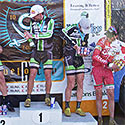 Riding hard causes micro tears in your muscles and connective tissue. In order to repair this damage, and to strengthen your body for the next workout, it's important to take in nutrition in the 30 minutes following your ride.
Riding hard causes micro tears in your muscles and connective tissue. In order to repair this damage, and to strengthen your body for the next workout, it's important to take in nutrition in the 30 minutes following your ride.
This is when your muscles are most capable of taking in nutrition and using it to recover and get stronger. A recovery shake that’s high in protein and carbohydrates is ideal because your body absorbs the nutrients faster than it would from solid food. Give yourself 10 to 30 minutes after your shake and enjoy your favorite post-race meal.
Bonus Tip: Since you usually have to drive to races, it's smart to bring a small cooler with your post-race meal inside. A gallon jug of water and a towel will make it easy to clean up too. And, don't forget the toilet paper, just in case.
What's left? Well, now that you're fed and cleaned up, you're ready for your first podium appearance. Congratulations!
